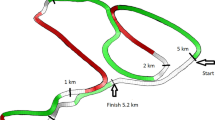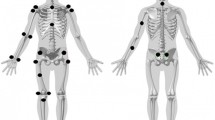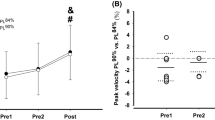Abstract
We investigated the hypothesis that longer and shorter poles would be faster and slower, respectively, than poles of self-selected length in all-out double poling. Eight elite cross-country skiers performed 80 m all-out double poling on snow performed from a standing start. Three trials with each of the pole lengths: self-selected, 7.5 cm shorter, and 7.5 cm longer than self-selected were performed. Time was recorded every 20 m and skiers were filmed during the last 40 m for calculation of cycle rate and length. Times at 80 m were 0.9 ± 0.7% shorter with longer poles than with self-selected poles (p ≤ 0.05), while they were 1.2 ± 1.0% slower with shorter poles (p ≤ 0.05). Much of these differences were established within the first 20 m. Calculated lead at 80 m with longer poles was 0.88 ± 0.65 m over self-selected poles (p ≤ 0.05). Mean cycle rate and length ranged from 1.35 to 1.45 Hz and from 4.84 to 5.52 m, respectively, across pole lengths (p > 0.05).




Similar content being viewed by others
References
Stöggl T, Lindinger S, Müller E (2006) Biomechanical validation of a specific upper body training and testing drill in cross-country skiing. Sports Biomech 5:23–46
Lindinger SJ, Holmberg H-C, Müller E, Rapp W (2009) Changes in upper body muscle activity with increasing double poling velocities in elite cross-country skiing. Eur J Appl Physiol 106:353–363
Smith GA, Fewster JB, Braudt SM (1996) Double poling kinematics and performance in cross-country skiing. J Appl Biomech 12:88–103
Holmberg H-C, Lindinger S, Stöggl T, Eitzlmair E, Müller E (2005) Biomechanical analysis of double poling in elite cross-country skiers. Med Sci Sports Exerc 37:807–818
Lindinger SJ, Stöggl T, Müller E, Holmberg H-C (2009) Control of speed during the double poling technique performed by elite cross-country skiers. Med Sci Sports Exerc 41:210–220
Holmberg H-C, Lindinger S, Stöggl T, Björklund G, Müller E (2006) Contribution of the legs to double-poling performance in elite cross-country skiers. Med Sci Sports Exerc 38:1853–1860
Smith GA (2000) Cross-country skiing: technique, equipment and environmental factors affecting performance. In: Zatsiorsky VM (ed) Biomechanics in sports: performance enhancement and injury prevention, pp 247–270
Nilsson J, Jakobsen V, Tveit P, Eikrehagen O (2003) Pole length and ground reaction forces during maximal double poling in skiing. Sports Biomech 2:227–236
Ludbrook J (1998) Multiple comparison procedures updated. Clin Exp Pharmacol Physiol 25:1032–1037
Currell K, Jeukendrup AE (2008) Validity, reliability and sensitivity of measures of sporting performance. Sports Med 38:297–316
Nilsson J, Tveit P, Eikrehagen O (2004) Effects of speed on temporal patterns in classical style and freestyle cross-country skiing. Sports Biomech 3:85–107
International Ski Federation (2009) Book II. Cross-country. International ski competition rules. Edition 2008
Strømme SB, Ingjer F, Meen HD (1977) Assessment of maximal aerobic power in specifically trained athletes. J Appl Physiol 42:833–837
Acknowledgments
The authors would like to express their thanks to the participants for their enthusiasm and cooperation during the study. Peter Solgård, and Thomas K. Kveum are acknowledged for assistance with testing.
Conflict of interest statement
The authors declare that they have no conflict of interest.
Author information
Authors and Affiliations
Corresponding author
Rights and permissions
About this article
Cite this article
Hansen, E.A., Losnegard, T. Pole length affects cross-country skiers’ performance in an 80-m double poling trial performed on snow from standing start. Sports Eng 12, 171–178 (2010). https://doi.org/10.1007/s12283-010-0042-3
Published:
Issue Date:
DOI: https://doi.org/10.1007/s12283-010-0042-3




